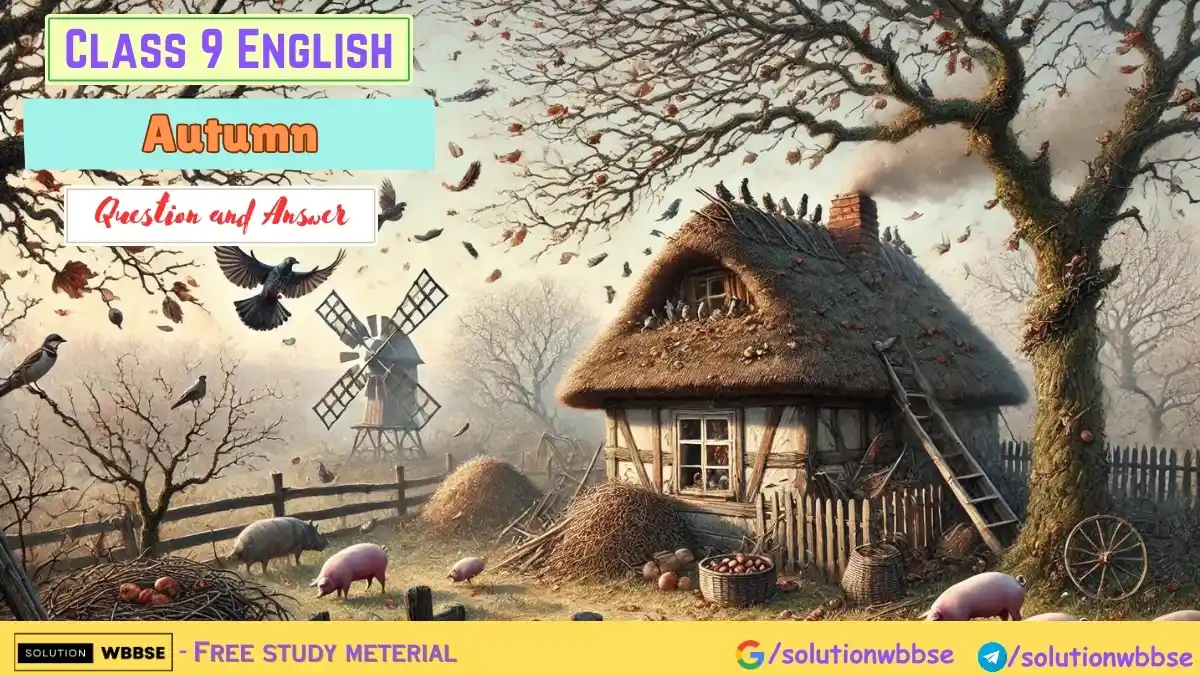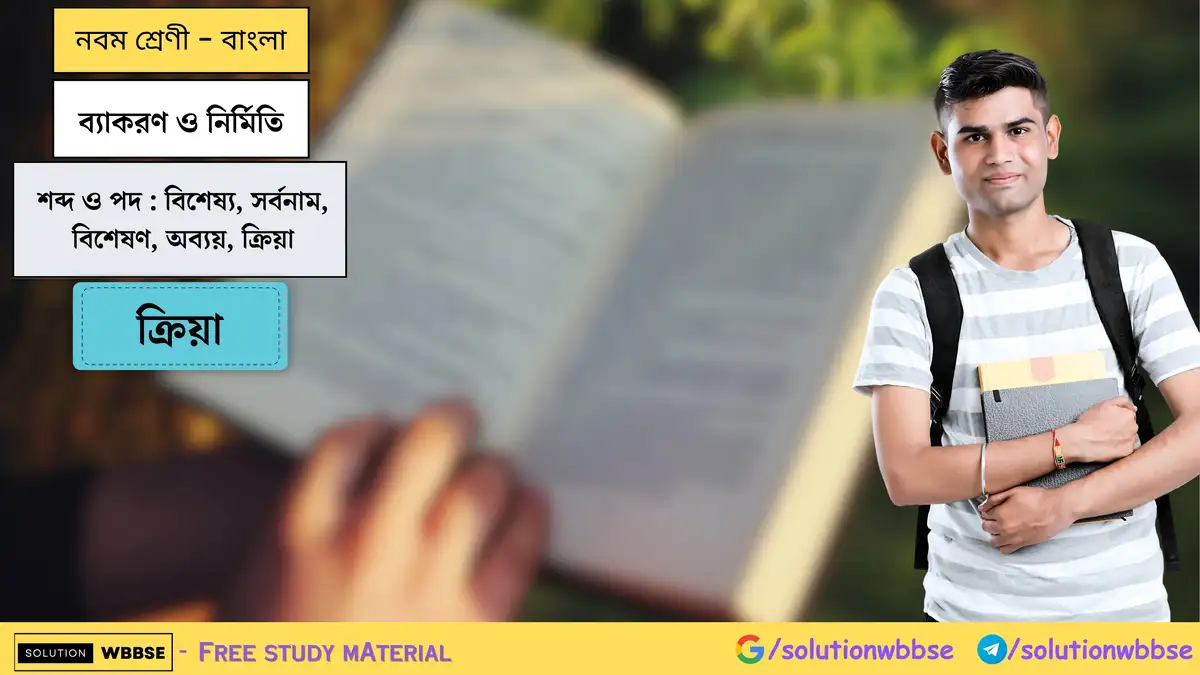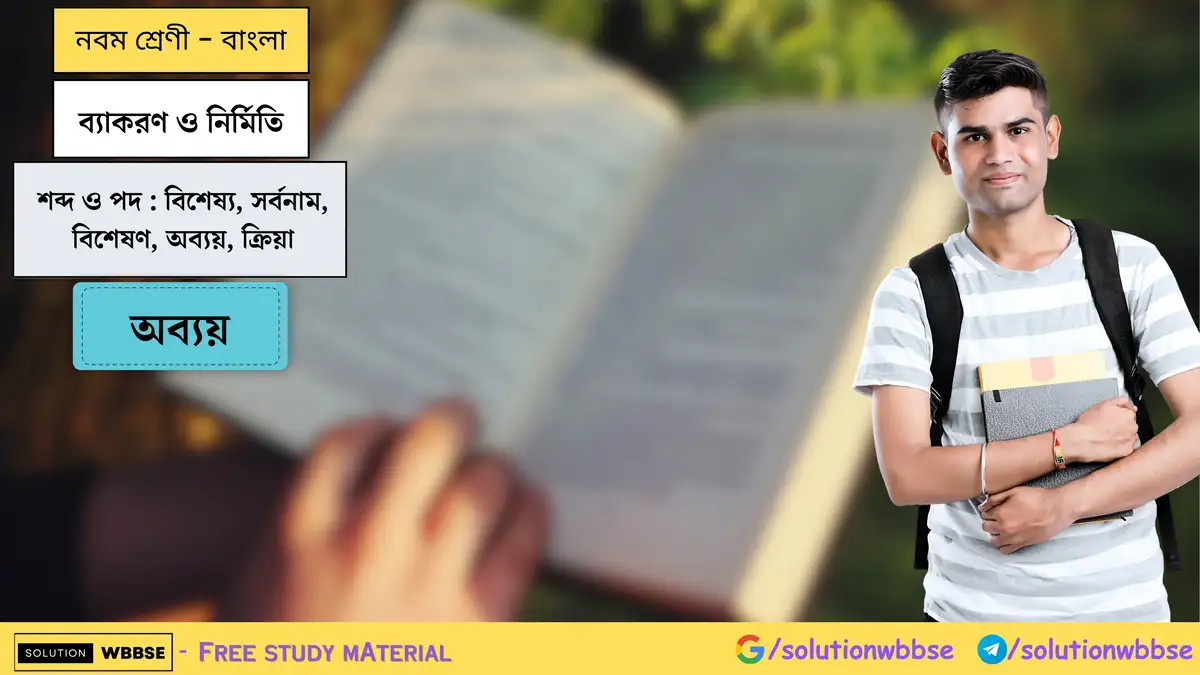আজকের আর্টিকেলে আমরা নবম শ্রেণীর ইংরেজির তৃতীয় অধ্যায় “Autumn” এর কিছু সংক্ষিপ্ত প্রশ্ন-উত্তর নিয়ে আলোচনা করবো। এই প্রশ্নগুলো নবম শ্রেণীর পরীক্ষার প্রস্তুতির জন্য অত্যন্ত গুরুত্বপূর্ণ। কারণ, এই প্রশ্নগুলো নবম শ্রেণীর পরীক্ষায় প্রায়ই দেখা যায়।

Autumn – Short Answer Type Questions
What does the poet love to see the fitful gust doing? (কবি দমকা হাওয়াকে কী করতে দেখতে পছন্দ করেন?)
The poet loves to see the fitful gust shaking the casement. (কবি দমকা হাওয়াকে জানালার পাল্লা নাড়াতে দেখতে পছন্দ করেন।)
How do the faded leaves fall on the lane? (কীভাবে নিষ্প্রভ পাতাগুলি রাস্তায় এসে পড়ে?)
The wind by the window pane twirls the faded leaves that fall on the lane. (জানালার ধারে হাওয়া এই নিষ্প্রভ পাতাগুলিকে ঘূর্ণি তুলে উড়িয়ে নিয়ে গিয়ে রাস্তায় এনে ফেলে।)
Where do the faded leaves ultimately lie? (অবশেষে মলিন পাতাগুলি কোথায় পড়ে থাকে?)
The faded leaves ultimately lie on the lane with other thousand leaves. (অন্যান্য হাজার পাতার সাথে এই মলিন পাতাগুলি রাস্তায় পড়ে থাকে।)
What dances till the shut of evening? (কী সন্ধ্যা অবধি নাচে?)
The shaking twig dances till the evening. (কম্পমান ডাল সন্ধ্যা অবধি নাচে।)
How does the twig dance? (কীভাবে ডাল নাচে?)
The twig dances as the wind blows against it. (ডালটি নাচে যখন হাওয়া তার বিপরীতে বয়ে যায়।)
Where does the sparrow sit? (চড়ুই কোথায় বসে?)
The sparrow sits on the cottage rig. (চড়ুই কুঁড়েঘরের চালে বসে।)
What does the sparrow do? (চড়ুই কী করে?)
The sparrow chirps. (চড়ুই কিচিরমিচির করে।)
What assurance does the sparrow’s chirp give to the poet? (চড়ুইয়ের কিচিরমিচির কবিকে কীসের আশ্বাস দেয়?)
The sparrow’s chirp makes the poet believe that spring is near. (চড়ুইয়ের কিচিরমিচির কবিকে আশ্বস্ত করে যে বসন্ত আসন্ন।)
What is spring doing? (বসন্ত কী করছে?)
Spring is flirting with flowers to sleep on summer’s lap. (বসন্ত গ্রীষ্মের কোলে জিরোবে বলে ফুলের সাথে খুনসুটি করছে।)
What does the poet find coming out from the cottage? (কবি কুঁড়েঘর থেকে কী বেরিয়ে আসতে দেখছেন?)
The poet finds smoke coming out from the cottage. (কবি বাড়ি থেকে ধোঁয়া বেরিয়ে আসতে দেখছেন।)
How does the smoke come out from the cottage? (কীভাবে ধোঁয়া বাড়ি থেকে বেরিয়ে আসে?)
The smoke curls up through the naked trees. (ধোঁয়া রিক্ত গাছের মধ্য দিয়ে কুন্ডলী পাকিয়ে ওঠে।)
Why are the trees termed naked? (কেন গাছগুলোকে রিক্ত বলা হয়?)
In autumn, winds make the trees shed their leaves leaving them bare. So they have been termed naked. (শরতের হাওয়া গাছগুলোর পাতা ঝরিয়ে দিয়ে নিঃস্ব করে দেয়, তাই তাদের রিক্ত বলা হয়েছে।)
Where do the pigeons nestle? (পায়রাগুলি কোথায় গুটিশুটি হয়ে বসে?)
The pigeons nestle round their nest. (পায়রাগুলি তাদের বাসায় গুটিশুটি হয়ে বসে থাকে।)
When do the pigeons nestle round their nest? (কখন পায়রাগুলি বাসায় গুটিশুটি হয়ে বসে থাকে?)
The pigeons nestle round their nest during dull November days. (পায়রাগুলি নভেম্বর মাসের ধূসর দিনে বাসায় গুটিশুটি হয়ে বসে থাকে।)
Why do the pigeons nestle round their nest on dull November days? (কেন পায়রাগুলি নভেম্বরের ধূসর দিনে গুটিশুটি হয়ে বসে থাকে?)
The pigeons nestle round their nest on dull November days because they do not feel encouraged to fly. (পায়রাগুলি নভেম্বরের ধূসর দিনে গুটিশুটি হয়ে বসে থাকে কারণ তারা উড়তে উৎসাহ বোধ করে না।)
Where does the cock crow? (কোথায় মোরগ ডাকে?)
The cock crows upon the dung-hill. (মোরগ আস্তাকুঁড়ের ওপর ডাকে।)
Where do the mill sails continue moving? (কোথায় পেশাই কলের পাল ঘুরতে থাকে?)
The mill sails continue moving on the heath. (মাঠের ওপর পেশাই কলের পাল ঘুরতে থাকে।)
Why do the mill sails move continuously? (কেন পেশাই কলের পাল অবিরাম ঘুরতে থাকে?)
The mill sails move continuously because the wind blows all the time. (পেশাই কলের পাল অবিরাম ঘুরতে থাকে কারণ সর্বক্ষণ হাওয়া বইতে থাকে।)
Where does the feather of raven fall? (কোথায় দাঁড়কাকের পালক পড়ে?)
The feather of raven falls on the stubble lea. (দাঁড়কাকের পালক খোঁচা খোঁচা ঘাসের জমির ওপর পড়ে।)
Where does the crow build its nest? (কোথায় কাক বাসা বাঁধে?)
The crow builds its nest on an oak tree. (কাক ওক গাছের ওপর বাসা বাঁধে।)
What falls from the oak tree? (ওক গাছ থেকে কী পড়ে?)
Small brown fruit called acorn falls from the oak tree. (অ্যাকর্ন নামক ছোট খয়েরি ফল ওক গাছ থেকে পড়ে।)
Who grunts and where? (কে ঘোঁৎঘোঁৎ করে এবং কোথায়?)
The pig grunts beneath the oak tree. (শুয়োর ওক গাছের তলায় ঘোঁৎঘোঁৎ করে।)
What does the grunting pig do? (শুয়োর ঘোঁৎঘোঁৎ করতে করতে কী করে?)
The grunting pig runs to the place where the acorn falls. (শুয়োর ঘোঁৎঘোঁৎ করতে করতে যেখানে অ্যাকর্ন ফল পড়ে সেখানে ছুটে যায়।)
Long Answer Type Questions
What activities of the autumn wind does the poet like? (শরতের হাওয়ার কী কী কার্যকলাপ কবির পছন্দ?)
The poet likes to see the wind shaking the casement all day. It drives the faded leaves from the mossy elm trees and makes the twig dance till evening. (কবি দেখতে পছন্দ করেন সারাদিন ধরে দমকা হাওয়া জানালাকে নাড়াচ্ছে। এটি শ্যাওলা ভরা এল্ম গাছ থেকে ধূসর পাতা উড়িয়ে নেয় এবং সন্ধ্যা অবধি গাছের ছোটো ডালকে নাচায়।)
What happens to the leaves of the mossy elm-tree in autumn? (শরতে শ্যাওলা ধরা এলম গাছের পাতাগুলির কী হয়?)
The leaves of the mossy elm-tree become faded in autumn. They are carried by the wind down the lane along with thousand other leaves. (শ্যাওলা ধরা এল্ম গাছের পাতাগুলি শরতে নিষ্প্রভ হয়ে যায়। হাওয়া তাদের আরো হাজার পাতার সাথে গলিপথ ধরে বয়ে নিয়ে যায়।)
What are the things the poet loves to see on November days? (নভেম্বর মাসের দিনে কবি কী কী দেখতে ভালোবাসেন?)
On November days the poet loves to see the cottage smoke which curls upwards through naked trees, the pigeons nestling round the cote, and the cocks crowing upon the dung-hill. (নভেম্বর মাসের দিনে কবি দেখতে পছন্দ করেন কুঁড়ে ঘর থেকে বেরোনো কুণ্ডলী পাকানো ধোঁয়া যা রিক্ত গাছগুলি বেয়ে উপরদিকে যায়, বাসার আশেপাশে গুটিশুটি দিয়ে বসে থাকা পায়রা এবং আস্তাকুঁড়ের উপর দাঁড়িয়ে ডাকতে থাকা মোরগ।)
How do the faded leaves fall on the ground? (কীভাবে ধূসর পাতা মাটিতে পড়ে?)
The strong wind drives the faded leaves from the mossy elm tree and then they spin round by the window pane. They fall on the ground and lie with other leaves on the lane. (এক দমকা শরতের হাওয়া ধূসর পাতাকে উড়িয়ে নিয়ে যায় শ্যাওলা ভরা এল্ম গাছ থেকে এবং তারপর জানালার পাল্লার চারধারে ঘোরে। তারা মাটিতে পড়ে এবং রাস্তায় ঝড়ে থাকা অন্যান্য পাতার সাথে পড়ে থাকে।)
What is the effect of the sparrow’s chirp on the poet? (চড়ুই-এর গুঞ্জন কবির ওপর কী প্রভাব ফেলেছিল?)
The sparrow’s chirp makes the poet feel as if spring is very near and is getting ready to lie with flowers on the lap of summer. (চড়ুই-এর গুঞ্জন কবিকে অনুভব করায় যেন বসন্ত খুব তাড়াতাড়ি এসে যাবে এবং ফুলেদের সঙ্গে নিয়ে গ্রীষ্মের কোলে জিরোবে বলে তৈরি হচ্ছে।)
What picture of cottage activity does the poet find? (কবি কুটিরের ভিতর কী কী কার্যকলাপ খুঁজে পান?)
In the evening, the household activities like cooking are done in the cottage and the smoke from there curls up through the bare naked trees. (বিকেলে, ঘরের কার্যকলাপ যেমন রান্না কুটিরের মধ্যে হয় এবং এর থেকে ধোঁয়া কুণ্ডলী পাকিয়ে রিক্ত গাছের মধ্যে ওঠে।)
What do the pigeons do and why? (পায়রারা কী করে এবং কেন?)
The poet finds the pigeons nestling round the cote. They do not fly far as the November days are not bright and full of mist, hence making it difficult to fly. (কবি দেখতে পান পায়রাগুলি গুটিশুটি হয়ে বাসার আশেপাশে বসে থাকে। নভেম্বর মাসে তারা দূরে উড়ে না কারণ দিনগুলি অনুজ্জ্বল এবং কুয়াশাচ্ছন্ন যার ফলে তাদের দেখতে অসুবিধা হয়।)
Where is the cock found? What is it doing there? (মোরগকে কোথায় পাওয়া যায়? সেখানে সে কী করে?)
The cock is found on the dung-hill. It is searching for food there in the form of worms and insects and it crows. (মোরগকে আস্তাকুঁড়ে পাওয়া যায়। সেখানে পোকামাকড় জাতীয় খাবার খোঁজে এবং ডাকে।)
What picture of the heath is given by the poet in the poem? (কবি এই কবিতায় মাঠের কী ছবি তুলে ধরেছেন?)
The sails of the mill are found moving continuously on the heath as the wind blows all the time. After the harvesting, the crops are processed there. (যেহেতু সর্বক্ষণ হাওয়া বয়, পেশাই কলের পাল একনাগাড়ে মাঠের ওপর ঘুরে চলে। ফসল কাটার পর, সেখানে ফসলগুলির ঝাড়াই বাছাই করা হয়।)
What does the poet say about the stubble lea? (কবি খোঁচা খোঁচা ঘাসের জমির সম্বন্ধে কী বলেছেন?)
A raven flies over the grass-covered land and it happens that a feather from its breast falls upon it. (একটি দাঁড়কাক খোঁচা খোঁচা ঘাসে ঢাকা জমির ওপর দিয়ে ওড়ে এবং এক সময় তার বুক থেকে একটি পালক খসে পড়ে।)
What happens near the old crow’s nest? (বুড়ো কাকের বাসার কাছে কী ঘটে?)
The old crow makes its nest on the oak tree. The fruits of the oak tree fall down to the ground. (ওক গাছের উপর বুড়ো কাক বাসা বাঁধে। সেই গাছের ফলগুলি কখনো কখনো টুপটাপ করে মাটিতে খসে পড়ে।)
How do the pigs behave as the acorns fall? (অ্যাকর্ন গাছ থেকে খসে পড়লে শুয়োররা কী করে?)
As soon as the acorns fall, pigs make grunting sounds and rush to the spot. (যেইমাত্র অ্যাকর্নগুলি পড়ে, শুয়োরেরা ঘোঁৎঘোঁৎ করতে করতে সেই স্থানে ছুটে যায়।)
Quote the expressions which help the poet depict the dreariness of the season. (আলোচ্য ঋতুর বিষন্নতা বোঝাতে কবিকে সাহায্য করেছে যেসব অভিব্যক্তি তাদের উল্লেখ করো।)
The expressions are – faded leaves, pigeons nestle round the cote, dull November days, etc. (অভিব্যক্তিগুলি হল – ধূসর পাতা, পায়রারা গুটিশুটি হয়ে বাসায় বসে থাকে, নভেম্বরের ধূসর দিনগুলো ইত্যাদি।)
What idea do you get from the poem about the poet? (এই কবিতা থেকে কবির সম্বন্ধে তুমি কী ধারণা পাও?)
The poet is a close observer of nature. He keenly notices the changes taking place in nature. Even he notices the changes in the countryside at the advent of autumn. (কবি গভীরভাবে প্রকৃতি পর্যবেক্ষণ করেন। তিনি তীক্ষ্ণ দৃষ্টিতে প্রকৃতির ঘটমান পরিবর্তনগুলি লক্ষ করেন। এমনকী গ্রামাঞ্চলে শরতের আগমনে প্রাকৃতিক বদলগুলিও লক্ষ করেন।)
What picture of the countryside does the poet depict in the poem? (এই কবিতায় কবি গ্রামাঞ্চলের কী ছবি তুলে ধরেছেন?)
The poet depicts the picture of the countryside in autumn. The countryside looks dull and dreary in this season. The trees become bare and the birds do not fly far. (এই কবিতায় কবি শরৎকালে গ্রামের রূপ তুলে ধরেছেন। এই ঋতুতে গ্রামাঞ্চল দেখায় নিষ্প্রভ ও বিষন্ন। গাছ রিক্ত হয়ে যায় এবং পাখিরা দূরে উড়ে যায় না।)
What common scenes of the countryside has the poet produced in the poem? (গ্রামাঞ্চলের কী কী সাধারণ দৃশ্য কবি এই কবিতায় তুলে ধরেছেন?)
The poet has referred to the chirping of the sparrow which is a common bird in the countryside. He has also mentioned pigeons, cocks, and ravens. (কবি সেই চড়ুইয়ের কিচিরমিচির উল্লেখ করেছেন যেই চড়ুইকে গ্রামে সবসময় দেখা যায়। তিনি এছাড়াও পায়রা, মোরগ এবং দাঁড়কাকের উল্লেখ করেছেন।)
What is personification? Mention 5 things that have been personified in this poem. (ব্যক্তিত্ব আরোপণ কী? ৫টি বস্তু উল্লেখ করো যার ওপর ব্যক্তিত্ব আরোপ করা হয়েছে।)
Personification is a literary device by which a plant, animal, or a thing is treated as human. (ব্যক্তিত্ব আরোপণ একটি সাহিত্য কৌশল যা দিয়ে গাছ, প্রাণী বা বস্তুকে ব্যক্তি হিসেবে বিবেচনা করা হয়।)
Wind, flowers, smoke, mill, and pigs are five personified things mentioned in this poem. (হাওয়া, ফুল, ধোঁয়া, পেশাই কল এবং শুয়োর হল পাঁচটি ব্যক্তিত্ব আরোপিত বস্তু যার উল্লেখ এই কবিতায় আছে।)
What happens near the old crow’s nest? (বুড়ো কাকের বাসার কাছে কী ঘটে?)
The old crow makes its nest on the oak tree. The fruits of the oak tree fall down to the ground. (ওক গাছের উপর বুড়ো কাক বাসা বাঁধে। সেই গাছের ফলগুলি কখনো কখনো টুপটাপ করে মাটিতে খসে পড়ে।)
আজকের আর্টিকেলে আমরা নবম শ্রেণীর ইংরেজির তৃতীয় অধ্যায় “Autumn” এর কিছু অতিসংক্ষিপ্ত প্রশ্ন-উত্তর নিয়ে আলোচনা করেছি। এই প্রশ্নগুলো নবম শ্রেণীর পরীক্ষার জন্য অত্যন্ত গুরুত্বপূর্ণ, কারণ এগুলো নবম শ্রেণীর পরীক্ষায় প্রায়ই দেখা যায়। আশা করি, এই আর্টিকেলটি আপনাদের জন্য উপকারী হয়েছে। আপনারা যদি কোনো প্রশ্ন বা অসুবিধার সম্মুখীন হন, তাহলে টেলিগ্রামে আমার সঙ্গে যোগাযোগ করতে পারেন, আমি উত্তর দেওয়ার চেষ্টা করবো। এছাড়া, নিচে এই পোস্টটি আপনার প্রিয়জনদের সঙ্গে শেয়ার করুন, যাদের এটির প্রয়োজন হতে পারে। ধন্যবাদ।






মন্তব্য করুন